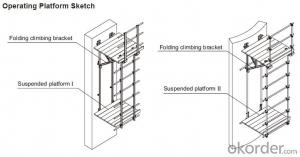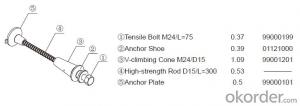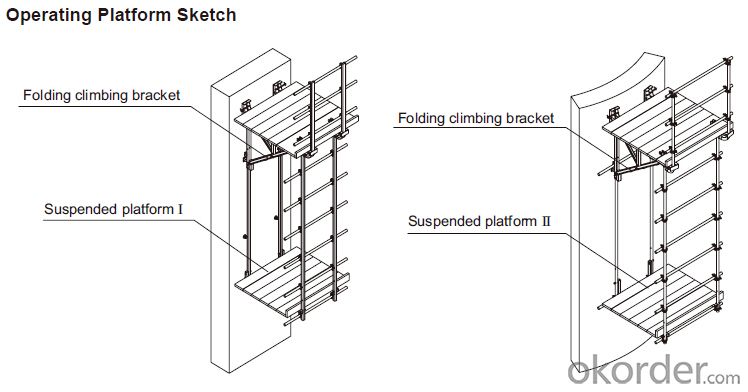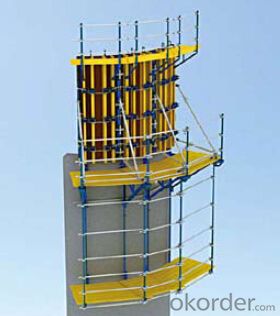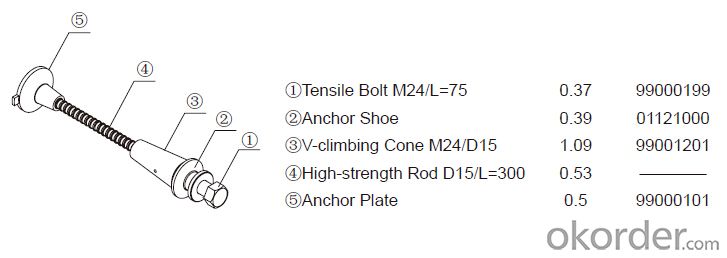Climbing Platform CP190 for formwork and scaffolding system
- Loading Port:
- Tianjin
- Payment Terms:
- TT OR LC
- Min Order Qty:
- 50 m²
- Supply Capability:
- 1000 m²/month
OKorder Service Pledge
OKorder Financial Service
You Might Also Like
Climbing Platform CP190
Climbing bracket CP190 is mainly used as operating platform during construction. It can be used
on the vertical wall and arced wall. The bracket hang on the anchor system and all the load are
supported by anchor system. It’s convenient to assemble and dismantle, the construction is easy,
rapid and safe.
Anchor System:
Anchor system is the most important supporting part. The system is made of five parts shown
below. There into, tensile bolt, anchor shoe and V-climbing cone can be taken out for reusing.
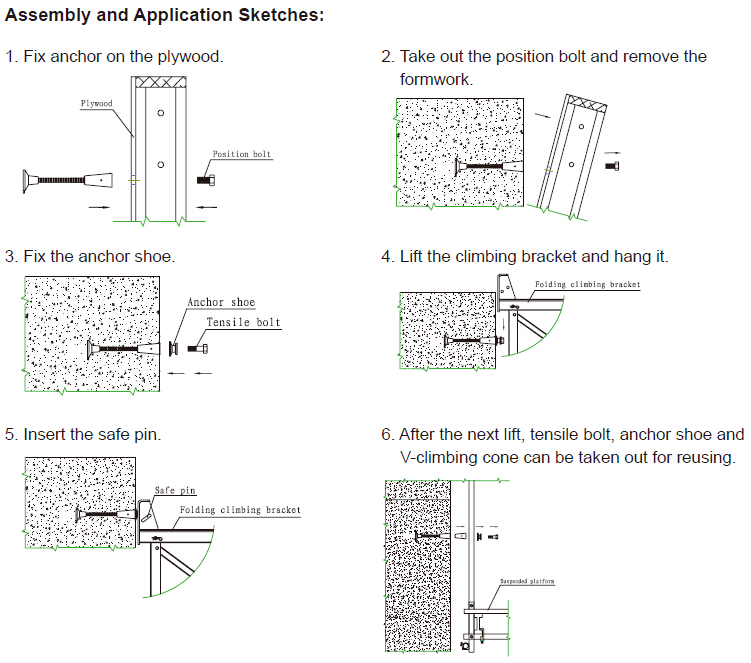
- Q: How does steel formwork handle formwork stripping and repositioning?
- Steel formwork is a highly durable and versatile option for handling formwork stripping and repositioning. It is designed to withstand the pressure exerted during the concrete pouring process and can easily handle the removal of the formwork once the concrete has set. When it comes to formwork stripping, steel formwork offers several advantages. Firstly, it provides a smooth surface finish to the concrete, ensuring a high-quality end result. The steel panels are typically coated with a protective layer, which prevents concrete from sticking to the formwork and facilitates easy stripping. The steel formwork system is engineered to allow for quick and efficient formwork removal. This is achieved through the use of various mechanisms such as wedge clamps, pins, or hooks, which securely hold the formwork panels in place during the pouring process. Once the concrete has achieved sufficient strength, these mechanisms can be easily released, allowing for smooth and effortless stripping of the formwork. Moreover, steel formwork can be easily repositioned and reused for multiple construction projects. The modular design of steel panels allows for flexibility in adjusting the formwork to different dimensions and shapes. This reusability significantly reduces the overall cost of formwork, making it a cost-effective solution for construction projects. Additionally, steel formwork offers excellent strength and stability, ensuring that the structure remains intact during the entire process of formwork stripping and repositioning. This is particularly important in high-rise or complex structures where the formwork needs to withstand significant loads and pressures. In summary, steel formwork is a reliable and efficient choice for handling formwork stripping and repositioning. Its durability, ease of use, and adaptability make it a preferred option for construction projects of various scales and complexities.
- Q: Can steel formwork be used for precast concrete wall panels?
- Yes, steel formwork can be used for precast concrete wall panels. Steel formwork offers several advantages for precast concrete construction. It provides high strength, durability, and dimensional accuracy, ensuring that the wall panels are of high quality. Steel formwork can easily be reused multiple times, making it a cost-effective option. It also allows for quick and efficient installation, reducing construction time. The flexibility of steel formwork enables the creation of various shapes and sizes of wall panels, meeting the design requirements of different projects. Overall, steel formwork is a suitable choice for precast concrete wall panels, offering numerous benefits in terms of strength, durability, efficiency, and cost-effectiveness.
- Q: Can steel formwork be used in marine construction projects?
- Yes, steel formwork can be used in marine construction projects. Steel formwork is a durable and versatile construction material that can withstand the harsh conditions of marine environments such as saltwater, waves, and corrosion. It is often used in marine construction projects for various applications such as building piers, docks, seawalls, and other structures that require a strong and stable foundation. Steel formwork provides excellent structural support and can withstand the heavy loads and pressures associated with marine construction. Additionally, steel formwork can be easily assembled and disassembled, making it a practical choice for marine construction projects where time and efficiency are crucial. Overall, steel formwork is a reliable and suitable option for marine construction projects.
- Q: How does steel formwork accommodate for different concrete curing durations?
- Steel formwork can accommodate for different concrete curing durations by providing a sturdy and durable structure that can support the weight of the concrete during the curing process. The steel formwork is designed to be reusable, allowing for easy removal once the concrete has cured to the desired strength. This flexibility in formwork material enables construction projects to adapt to different curing durations without compromising the structural integrity of the concrete.
- Q: Are there any environmental benefits to using steel formwork?
- Yes, there are several environmental benefits to using steel formwork in construction projects. Firstly, steel formwork is highly durable and can be reused multiple times, reducing the need for new formwork materials. This significantly reduces the amount of waste generated during construction, as traditional formwork materials like timber are often discarded after a single use. By using steel formwork, construction companies can minimize their environmental footprint by reducing the amount of waste sent to landfills. Additionally, steel formwork is recyclable, meaning that at the end of its lifecycle, it can be recycled and repurposed into new steel products. This helps to conserve natural resources and reduce the demand for raw materials. Furthermore, the energy required to recycle steel is significantly less than the energy required to produce new steel, resulting in reduced greenhouse gas emissions. Steel formwork also offers advantages in terms of energy efficiency. Compared to traditional formwork materials, steel formwork requires less energy to manufacture and transport, resulting in lower carbon emissions. Furthermore, steel formwork is known for its high strength and rigidity, which allows for the construction of more slender and lightweight structures. This can lead to reduced material consumption and subsequently lower energy requirements for heating, cooling, and lighting in the constructed buildings. Lastly, steel formwork is resistant to moisture, fire, and pests, reducing the need for chemical treatments and preservatives that can harm the environment. This makes steel formwork a more sustainable option and reduces the negative impact on ecosystems and human health. Overall, the use of steel formwork in construction projects offers several environmental benefits, including reduced waste generation, increased recycling opportunities, energy efficiency, and reduced reliance on harmful chemicals. By choosing steel formwork, construction companies can contribute to a more sustainable and environmentally-friendly construction industry.
- Q: What are the different safety training requirements for steel formwork installation?
- The safety training requirements for installing steel formwork may differ depending on the regulations and guidelines established by various countries and organizations. Nevertheless, here are some typical safety training requirements that are commonly applicable: 1. All workers involved in steel formwork installation must undergo general construction safety training, which covers topics such as recognizing hazards, using personal protective equipment (PPE) correctly, fall protection, and proper lifting techniques. 2. Workers should receive specialized training on the specific techniques and procedures related to steel formwork installation. This training may include learning how to assemble and dismantle formwork properly, securing it to prevent collapse, and ensuring stability during concrete pouring. 3. Workers should be trained on operating any equipment used during steel formwork installation, such as cranes or forklifts, in a safe manner. 4. Workers should receive training on hazard communication, including understanding safety signs and labels, handling hazardous materials, and knowing how to respond to emergencies. 5. It is important for workers to be trained in first aid and CPR techniques to be prepared for any accidents or injuries that may occur during steel formwork installation. 6. If scaffolding is used during the installation process, workers should undergo scaffold safety training to understand how to assemble, use, and dismantle scaffolding safely. 7. Depending on the specific tasks involved in steel formwork installation, workers may need additional job-specific safety training. This could include training on working at heights, using power tools, or working in confined spaces. Employers and workers must comply with the relevant safety regulations and ensure that all necessary training is provided to create a safe working environment during steel formwork installation.
- Q: How does steel formwork impact the overall energy efficiency of a structure?
- The overall energy efficiency of a structure can be significantly affected by the use of steel formwork. Firstly, the durability of steel formwork allows for repeated use, reducing the need for new materials for each construction project. This helps to decrease the energy consumed in manufacturing and transporting formwork materials. Furthermore, steel formwork is renowned for its excellent thermal conductivity, enabling efficient heat transfer. This is especially important in structures prioritizing energy efficiency, like residential or commercial buildings. Efficient heat transfer helps to maintain a comfortable indoor temperature, minimizing the need for excessive heating or cooling and thus reducing energy consumption. Additionally, steel formwork can contribute to the overall insulation of a structure. By combining insulating materials with steel formwork, a building's thermal performance can be greatly improved. This insulation prevents heat loss during colder months and heat gain during warmer months, reducing the reliance on artificial heating and cooling systems. Consequently, energy consumption is decreased, resulting in improved energy efficiency. Moreover, steel formwork can be designed to incorporate elements that enhance natural lighting and ventilation in a structure. Allowing more natural light into the building reduces the need for artificial lighting during daylight hours, leading to lower energy consumption. Similarly, promoting natural ventilation through steel formwork decreases the necessity for mechanical ventilation systems, further contributing to energy efficiency. Lastly, the strength and stability of steel formwork enable the construction of innovative and energy-efficient structural designs. It allows for the utilization of larger open spaces, reducing the need for additional structural components and materials. This not only lowers construction costs but also decreases energy consumption associated with producing and transporting these extra materials. In conclusion, steel formwork positively impacts the energy efficiency of a structure through its durability, thermal conductivity, insulation properties, natural lighting and ventilation features, and its ability to enable innovative structural designs. By reducing energy consumption in various ways, steel formwork contributes to the sustainability and long-term energy efficiency of a building.
- Q: Can steel formwork be used for residential construction projects?
- Yes, steel formwork can be used for residential construction projects. Steel formwork offers several advantages such as durability, reusability, and high load-bearing capacity, making it suitable for both small and large-scale residential projects. Additionally, steel formwork allows for precise and efficient construction, ensuring high-quality finishes in residential buildings.
- Q: How does steel formwork contribute to improved construction site access?
- Steel formwork contributes to improved construction site access by providing a strong and durable structure that allows for easy and safe movement of workers, equipment, and materials. Its robustness ensures that it can withstand heavy loads and constant use, minimizing the risk of accidents or collapses. Additionally, steel formwork can be easily assembled and disassembled, allowing for efficient and quick access to different areas of the construction site. Its versatility also enables the creation of customized shapes and sizes, adapting to the specific needs of each project and ensuring smooth and unrestricted access throughout the construction process.
- Q: Can steel formwork be used for concrete structures in marine environments?
- Steel formwork can be used for concrete structures in marine environments, but it requires special considerations and precautions. Marine environments, with their high levels of saltwater exposure and corrosive elements, pose unique challenges for steel formwork. The corrosive nature of the seawater can cause rapid deterioration and rusting of the steel formwork, compromising its structural integrity. To mitigate these risks, it is necessary to use high-quality corrosion-resistant steel, such as stainless steel or galvanized steel, for the formwork. These materials have better resistance to corrosion and can withstand the harsh marine environment for a longer period. Additionally, proper maintenance and regular inspection are essential to identify any signs of corrosion or damage and address them promptly. This may involve cleaning the formwork regularly, removing any accumulated salt or debris, and applying protective coatings to prevent corrosion. Furthermore, it is important to consider the design of the formwork to ensure proper drainage and minimize water exposure. Adequate provision for drainage channels and weep holes should be included to avoid the accumulation of water, which can accelerate corrosion. In conclusion, while steel formwork can be used in marine environments, it requires careful selection of corrosion-resistant materials, regular maintenance, and proper design considerations to ensure its durability and longevity. It is recommended to consult with experienced professionals and engineers who have expertise in marine construction to ensure the success of concrete structures in such environments.
Send your message to us
Climbing Platform CP190 for formwork and scaffolding system
- Loading Port:
- Tianjin
- Payment Terms:
- TT OR LC
- Min Order Qty:
- 50 m²
- Supply Capability:
- 1000 m²/month
OKorder Service Pledge
OKorder Financial Service
Similar products
Hot products
Hot Searches
Related keywords
